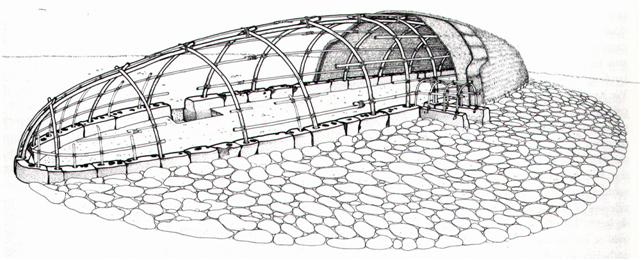In rongorongo times the season of
sailing (and fishing) should have begun when
Tau-ono became visible late at night in
May 31 (151):
This season ought then to
be over when their lost sister Mortal
took command, when the canoes were drawn up on
land and were turned over
to become houses, when the fishing was
over.

... According to mythology, Alcyone and Celaeno were both seduced by Poseidon. Maia, the eldest and most beautiful of the sisters, was seduced by Zeus and gave birth to Hermes; she later became foster-mother to Arcas, son of Zeus and Callisto. Zeus also seduced two others of the Pleiades: Electra, who gave birth to Dardanus, the founder of Troy; and Taygete, who gave birth to Lacedaemon, founder of Sparta. Asterope was ravished by Ares and became mother of Oenomaus, king of Pisa, near Olympia, who features in the legend of Auriga. Hence six Pleiades became paramours of the gods. Only Merope married a mortal, Sisyphus, a notorious trickster who was subsequently condemned to roll a stone eternally up a hill ...
... Merope often is considered the Lost Pleiad, because, having married a mortal, the crafty Sisyphus, she hid her face in shame when she thought of her sisters' alliances with the gods, and realized that she had thrown herself away. She seems, however, to have recovered her equanimity, being now much brighter than some of the others. The name itself signifies 'Mortal' ...
Rolling a stone upwards is the opposite of sailing lazily with the stream. Atlas stood still as a statue with his Sky ball high on his shoulders, whereas Sisyphus never was able to quit moving his stone (tau) upwards. Like Mercury he was never still.


Possibly Merope was Spica, the
Virgin's Girdle, but σ
Virginis may have been more significant:
| Egyptian tusk |
 |
Phoenician shin |
 |
Greek sigma |
Σ (σ, ς) |
|
Wikipedia: Shin (also spelled Šin (šīn) or Sheen) literally means 'teeth, 'press', and 'sharp' ...
The Mayan 'grasping hand' (Chikin) in the west was also called 'the biting or eating of the Sun': ... But in the final confirmation, we have the direct evidence of the signs for East and West. For the East we have the glyph Ahau-Kin, the Lord Sun, the Lord of Day; for the West we have Manik-Kin, exactly corresponding to the term Chikin, the biting or eating of the Sun, seizing it in the mouth ... |
 |
 |
 |
 |
 |
 |
 |
| Ga5-22 |
Ga5-23 |
Ga5-24 |
Ga5-25 |
Ga5-26 (136) |
Ga5-27 |
Ga5-28 |
| JULY 31 |
AUGUST 1 |
2 |
3 |
4 (216) |
5 |
6 |
| δ Muscae (196.5), Vindemiatrix (196.8) |
13h (197.8) |
Apami-Atsa, ψ Hydrae (198.5) |
Al Dafīrah (199.4) |
σ Virginis (200.4) |
γ Hydrae (201.0), ι Centauri (201.4) |
Al Simāk-12 / Chitra-14 / Horn-1 / Sa-Sha-Shirū-20
ANA-ROTO |
| ξ¹ Centauri (197.1), ξ² Centauri (197.9) |
Mizar (202.4), SPICA, Alcor (202.7)
Sadalmelik
|
| October 3 |
4 |
5 |
6 |
7 (280) |
8 |
9 |
| NAKSHATRA DATES: |
| JANUARY 30 |
31 |
FEBRUARY 1 |
2 |
3 (399) |
4 |
5 (36) |
| no star listed (14) |
1h (15.2) |
Al Batn Al Hūt-26 / Revati-28 |
ν Phoenicis (17.4), κ Tucanae (17.6) |
no star listed (18) |
Adhil (19.3) |
Ksora (20.1), ω Andromedae (20.6), γ Phoenicis (20.8) |
| β Phoenicis (15.1), υ Phoenicis, ι Tucanae (15.6), ζ Phoenicis (15.7) |
MIRACH, Keun Nan Mun (16.0), Anunitum (16.5), REVATI (16.9)
Regulus
|
| April 4 |
5 |
6 |
7 |
8 |
9 |
10 (100) |
| April 5 |
6 |
7 |
8 |
9 (465) |
10 (100) |
 |
 |
 |
 |
 |
 |
| *Ca14-18 |
*Ca14-19 |
*Ca14-20 |
*Ca14-21 (384) |
*Ca14-22 |
*Ca14-23 |
| te honu paka |
te henua |
honu kau |
te mata |
te honu |
kua heheu |
 |
 |
 |
 |
 |
 |
| Aa1-1 |
Aa1-2 |
Aa1-3 |
Aa1-4 |
Aa1-5 |
Aa1-6 |
| tagata ui |
ki tona marama |
e tagata noho ana - i te ragi |
te tagata - hakamaroa ana i te ragi |
ko te moa |
e noho ana ki te moa |
 |
 |
 |
 |
 |
 |
| Aa1-7 |
Aa1-8 |
Aa1-9 |
Aa1-10 |
Aa1-11 |
Aa1-12 |
| e moa te erueru |
e moa te kapakapa |
e moa te herehua |
ka hora ka tetea |
ihe kuukuu ma te maro |
ki te henua |
|
e moa te erueru |
Oh rooster, who scratches diligently! |
|
e moa te kapakapa |
Oh rooster, who beats his wings! |
|
e moa te herehua |
Oh rooster, who ties up the fruit! |
|
ka hora |
Spread out! |
|
ka tetea |
Have many descendants! |
Spica could then be the place where many descendants were spreading out like roots.
|











